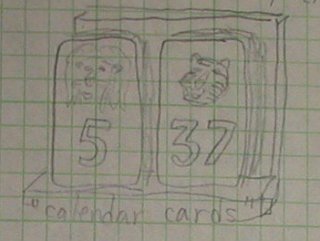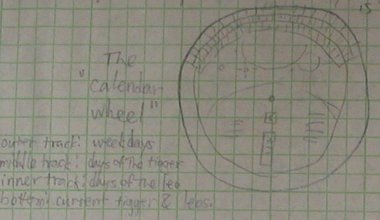
William S. Burroughs once compared Time magazine to the Mayan calendar, which told people which days were fortunate or inauspicious, which days to feel happy or sad. The calendar in use on Hinkson
Settlers on Hinkson Tourmaline IV were spread out across the face of the planet, most of them in the habitable/arable zones near oceans or other bodies of water, and many of them around the Third Ocean on the Catseyeward side of the planet. Here they could never forget why the official name of Hinkson Tourmaline IV in the planetary register was the planet Eclipse; for overhead the planet Catseye loomed huge, stretching across a sixth of the sky. The star Hinkson's Tourmaline was eclipsed by Catseye every day, so that the daily cycle consisted of morning, afternoon, night, and also midnight noon whose darkness clove and divided morning from afternoon.
Catseye overhead by day, a huge crescent waning and waxing, reduced to darkness in the dark sky during the hour of midday totality. A dark sphere with lightning and auroral displays raging across its face in the dark overhead. Then at night, after Hinkson's Tourmaline had set and the sky grown dark, Catseye above waxed to full, lighting up the night like a hundred full moons, and across the face of Catseye moved the round shadow of Hinkson Tourmaline IV, like the black pupil moving across a rolling eye. And again, with lightning raging in the pupil of the eye, in the night sky overhead...
Burroughs was right. Night and day and sky determine the calendar, and then calendar and environment determine the rhythm and feel of day-to-day. Day and Year and Week and Month...
Day: Hinkson Tourmaline IV, which always keeps the same side toward its primary, the large terrestrial planet Catseye, both rotates around Catseye and revolves on its axis once every 13.738 hours. Thus the Day is reckoned as a period of 13.738 hours.
On the primaryward side, the primary eclipses Hinkson's Tourmaline daily. Transition to or from totality takes only about a minute, and totality lasts about 62 minutes at the equator. Eclipse is slightly shorter at higher latitudes.
In most settlements on Hinkson Tourmaline IV, day is held to begin at local sunrise. But in some settlements on the Catseyeward side of the planet, the new day begins at the end of the morning, at the first moment of total eclipse at the onset of "midnight noon." Local calendar variations like this arose in the early days of colonization, when various human settlements on the planet were widely dispersed and struggling, and often not in regular communication with one another. These differences have never been ironed out, due in part to the peculiar role the day plays in the calendar of Hinkson Tourmaline IV (see Week below).
Year: The Catseye/Eclipse double planetary system revolves in its orbit around Hinkson's Tourmaline once every 528.67 Earth days. Thus a year on Hinkson Tourmaline IV lasts 923.57 local days.
Accordingly, the calendar year is 924 local days long. Three years out of seven are "short years," only 923 days long. A "short year" drops its last day. A year is a short year if, when divided by 7, the remainder is odd (1, 3, or 5).
The Hinkson's Year era (years HY) begins with
Week: Catseye turns on its axis precisely twice every three local days, so every three days Catseye presents the same aspect in the sky overhead at the same time of the day. This leads to a three-day rhythm in the week: Foreday, Middleday, and Hinterday. Four such three-day periods constitute one week of twelve local days:
- Green Foreday
- Yellow Middleday
- Red Hinterday
- White Foreday
- Green Middleday
- Yellow Hinterday
- Red Foreday
- White Middleday
- Green Hinterday
- Yellow Foreday
- Red Middleday
- White Hinterday
A twelve-day week accommodates all of these "daily" cycles. Which length of cycle one followed was to a large degree a family-by-family choice, though it was also to some degree a matter of locale, cycles of a given length being more popular in one settlement than in another. And sometimes a particular cycle was common to a guild or trade.
This led to a culture in which one's daily schedule faded into and out of sync with one's friends and neighbors. Today, your schedule and mine might come into alignment so that we might meet for lunch at what was for both of us midday; a few days later, and my workday might coincide with the middle of your night. Not exactly a lazy schedule of "mañana," but a schedule in which phases come and go, fade in and out, in ever drifting evanescence. Half the world is sleeping while I am awake; and not always the same half, either.
And even if we both keep to a cycle of the same duration, I might wake and work during Foreday and Middleday, and sleep during Hinterday; while you might be up Middleday and Hinterday, and asleep Foreday.
Nor did sky in its light and darkness mark the bounds strongly: the nighttime was lit up by the light of Catseye overhhead, and every midday was plunged into an hour of deep darkness. No matter what the length of your "day," you could not escape a cycle in which both light and darkness featured in both your waking and your sleep time.
Think for a moment what it would be like to live in a world where day and night, waking and sleeping, light and dark, and most of all my schedule and yours, shifted and slid in the fleeting and evanescence of such a hall of mirrors.
Months: Catseye and Hinkson Tourmaline IV share two small moons which orbit their common center of gravity: the Lion, visible in the sky as a small yellow disk, with a period of 21.38 days; and the Tiger, visible as a brilliant orange star, with a period of 43.89 days. These suggest two mensal periods of 21 days (called a "leo") and 44 days (called a "tigger").
Coincidentally, the product of 21 and 44 is 924— the number of local days in a year! Moreover, 21 and 44 are relatively prime. Thus if these two cycles run concurrently, each will fill out a long (924-day) year evenly, and each of the 21 "days of the leo" will coincide with each of the 44 "days of the tigger" once and only once during the year. A year will be made up of:
- 77 weeks of 12 days each
- 44 leos of 21 days each
- 21 tiggers of 44 days each

Combining days of the leo and tigger with the days of the week yields the complete way calendar days were specified on Hinkson Tourmaline IV. For instance, today might be Red Middleday

The question "Which leo and which tigger of the year is it?" can be answered by aligning the yellow 5 and orange 37 on a common device known as the calendar wheel, which also usually includes a track for days of the week. This device, if adjusted once every tigger, can also serve as a sort of perpetual monthly calendar.
In a short year of 923 days, the last day of the year
Note how the calendar of Hinkson Tourmaline IV, with its two intertwining mensal periods of Lions and Tigers, is better adapted to answering the question, "Where am I in the superimposed rhythm of various cycles?", than to answering the question, "Where am I in the year considered 'in the large'?" Such a calendar is better adapted to a world where numerous cycles predominate, and the seasons of the year are not so strongly marked. Catseye and Hinkson Tourmaline IV both have essentially zero axial inclination toward the plane of their revolution around each other, and this plane is inclined at only about 9° toward the ecliptic. Thus there are seasons on Hinkson Tourmaline IV, though they are much less strongly marked than on Earth with its 23° axial tilt. And the seasons were even further moderated for most of the settlers, living as they did near one of the oceans.
And there you have it, a star system of my own! I have tons of items like this stored away in all those zillions of boxes of old papers I've got stored away. Goes along, I think, with my overall radioactive core meltdown of the imagination.
it does sort of remind me of the mayan calendar and 'a reality of its own' attached i like it
ReplyDelete